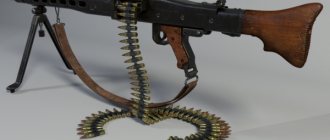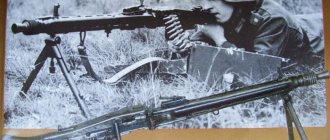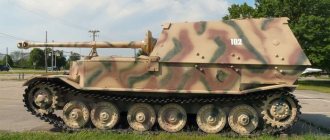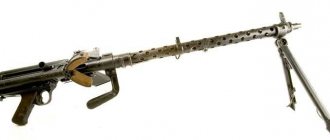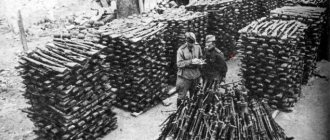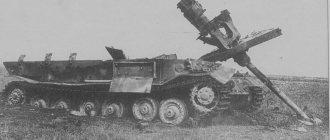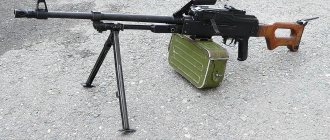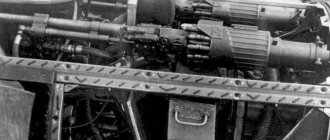History of creation
The First World War showed that a new, powerful player had appeared on the battlefield - the machine gun. The first models of machine guns were bulky and heavy. They performed excellently in defense, but it was difficult to go on the attack with a 60-kilogram colossus.
The difference between light and heavy machine guns, as well as models for equipment, led to confusion and problems with personnel. The Germans unraveled this tangle quickly and wittily. In the 1930s, the development of a single combined arms machine gun began, which led to the creation and adoption by commissions of the MG-34.
The resulting car turned out to be extremely successful.
Excellent characteristics with a relatively low weight, the ability to be installed on a machine and in turrets and caponiers made this machine gun indispensable for the Wehrmacht.
But at the same time, serious shortcomings also emerged. The price of the machine gun was 327 marks, while the Volkswagen Beetle was sold at a price of 990 marks.
Many parts were created by milling, which increased creation time and increased cost. Inspections on the battlefields also revealed design defects.
The parts fitted to each other were afraid of dirt, and problems arose with excessive complexity during assembly and disassembly and replacement of parts. However, even before the MG-34 was put into service, work began on creating a more technologically advanced model, which became known as the MG-42.
The design of the new machine gun
Several German design bureaus received orders for a new machine gun at once. The designers of Rheinmetall coped with the task best. The designers made numerous changes to the scheme, among which the most important were the following:
- replacement of milling with stamping for a number of parts;
- replacing screw connections with riveting or soldering;
- reduction in cost due to the use of lower quality metal;
- reduction of parts by 200 pieces;
- changing the butt from wood to plastic.
The mechanics of the machine gun are based on the recoil of the barrel during a short stroke. Shooting began with cocking the long bolt handle, with the ability to put the safety on if necessary.
The impact mechanism consisted of a return spring. The rear sear ensured the shot. Pressing the trigger lowered the nose of the sear, the spring straightened and sent the bolt back. The bolt, in turn, removed the cartridge from the tape and sent it into the chamber. The shot was fired with the shutter open.
The barrel is locked by two rollers in the combat cylinder. This was quite a revolutionary decision. The parts not only ensure smooth shooting, but also reduce friction. The trigger mechanism is installed in the pistol grip, where the safety is also located.
It was possible to conduct only automatic fire.
Aiming was carried out through an open sight, consisting of a front sight and rear sight. The scale was divided into steps of 100 meters, with the ability to fire from 200 to 2000 meters. The sighting bar clamp moved with a click. It could be displayed with eyes closed or in complete darkness.
The barrel is cooled from overheating using air masses. The casing is in the form of a rectangle, with large cutouts along the body. On one side there was a hole for quickly changing the barrel.
According to the engineers' recommendations, this part had to be changed every 150 shots to prevent overheating. The main advantage of the MG-42, and at the same time the main headache, is the rate of fire. 1200 rounds per minute guaranteed and quickly killed the barrel.
The second number of the crew had with him a set of replacement barrels and an asbestos glove so as not to burn his hand. A machine gunner replaced an overheated barrel in an average of 5-8 seconds. The regulations prescribed shooting in short bursts of no more than 250 rounds to preserve the barrel. Experienced fighters could fire bursts of 3-5 shots.
Barrel problem
Even on the MG 34 model, the Germans solved the problem of barrel overheating in a crude but effective way. It was also passed on to the older brother: the overheated barrel was simply snapped off from the body (a special clamp was provided for this), and a new one was put in its place. The entire operation took no more than a couple of seconds and could be performed with one hand.
Comparative characteristics of MG-42
A complete picture of a weapon can be obtained by looking at its closest competitors. At this time, the most common infantry light machine guns were the English Bran and the Soviet DP-27.
- the mass indicator of the MG-42 is the largest, 12.6 kg, while the Englishman weighs 11.5 kg, and the DP - 10.6 kg;
- weapon length is 121.9 cm, the same figure for Bran and DP is 115 cm and 127.2 cm, respectively;
- the bullet flies out of the barrel at a speed of 750 m/s, for analogues it is 745 and 840 m/s;
- rate of fire 1200 rounds per minute, English model 660, Soviet 600;
- ammunition supply from a tape packed in a “snail” for 50 rounds or from a box for 250 rounds, Bran with a magazine for 30 rounds, the DP has a disk for 47 rounds;
- cartridges, respectively, 7.92x57 for MG-42, 7.7x56 (.303) for Bran and 7.62x53R for DP.
The analysis shows that, compared to its competitors, the German MG-42 is superior in many respects to its counterparts from opposing countries. Coupled with its low cost and successful ergonomics, this made the German a formidable adversary both tactically, on the battlefield, and in the strategic battle of economies.
A dark horse
An army contract containing very detailed command requirements was received by a hitherto unknown. As the name suggests, the company had never been involved in development in its life, but here it immediately put forward a project that met literally all the requirements and was, moreover, relatively cheap to produce.
Use on the battlefield
After testing experimental models in the winter of 1941-1942, the sample was put into service under the designation MG-42. The appearance did not go unnoticed; Soviet intelligence drew conclusions about Germany’s resources coming to an end, not suspecting that the Germans had been developing a greatly simplified and cheaper machine gun before the war.
The troops liked the new weapon. The machine gun immediately received several nicknames, mostly related to the circular saw. The sound of the shooting machine really resembled a woodworking machine.
The Allies received the ominous nickname “Widowmaker” for the MG-42. The gloomy name did not prevent the use of a formidable weapon as a trophy, despite the provision on the surrender of captured weapons to special detachments.
The fire of German machine guns created a continuous barrier, through which it was almost impossible for enemy infantry.
Only during the barrel change was it possible to make dashes or maneuvers. This factor caused severe psychological damage to those who had to storm the MG-42 positions.
Produced since the fall of 1942, the MG-42 faithfully served its owners until April-May 1945. After the end of the war, many units of these weapons were in service with underground gangs, as well as in third world countries.
MG 74
Now a modified model of the old “Bone Cutter” is also in service in many countries. The latest successful variation is the Austrian MG 74 machine gun, which differs little from its predecessor. The Austrian killing machine received a polymer handle and butt, learned to conduct single fire, but overall it remained the same legendary machine gun that caused so much trouble to the soldiers of the valiant Red Army.
Stopping the production of machine guns
After the collapse of Nazi Germany, the production of machine guns was stopped. The Allies were dealing with the legacy of victory, one of which, of course, was the development of German gunsmiths to improve the MG-42.
Just a few years later, work on improving the German machine gun and creating prototypes in Western countries continued.
The design turned out to be so successful that this machine gun is still in service with the Bundeswehr, although modernized for the standard NATO cartridge 7.62x51 mm. Now it has a new name - MG-3. Besides Germany, this machine gun is used in some European countries as the main one.
Predecessor
The German army needed a machine gun that was easy to learn and maintain, which could be head and shoulders above similar enemy equipment. The first test ball can be considered the MG 34 machine, created by Rheinmetall AG. The light (only 12 kg), relatively compact and fast-firing machine gun had one significant drawback: it was too expensive for the needs of the Third Reich. It was supplied to the army, but at the same time a new, easier to maintain and cheaper vehicle was being developed.
Trace in culture
The Second World War was widely reflected in artistic culture. The image of the German soldier trying to conquer the world for his Fuhrer is known in all corners of the Earth.
Not a single serious film or book could ignore the topic of MG-42.
The merciless “saw”, firing at both soldiers going on the attack and civilians, is found in hundreds of artistic descriptions of the past war.
If you remove emotions, you will be left with an excellent example of weapons, a machine gun, which served as the progenitor of the direction of single machine guns, which is used to this day.
MG 42
The army needed a single machine gun with high firepower and the cheapest possible production - the army received it. Thanks to the stamping of the receiver, the machine guns were manufactured quickly and more technologically than the previous MG 34. The machine was simplified to the maximum: the possibility of feeding the belt from any side was removed, magazine feed and a fire mode switch were abandoned. All this made it possible to obtain an almost ideal machine gun: simple, reliable, cheap and fast-firing.
